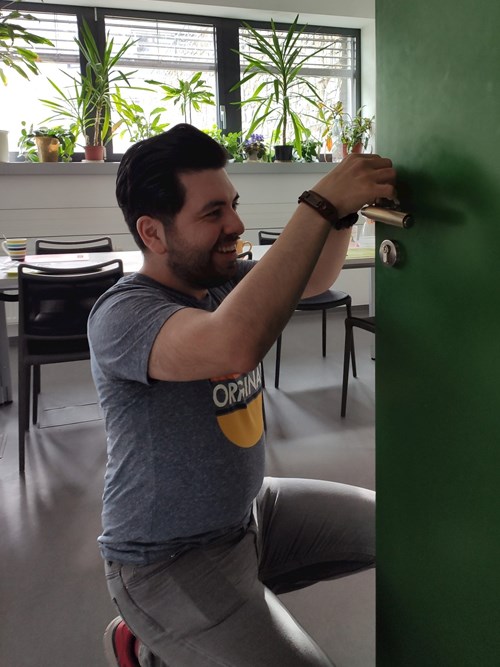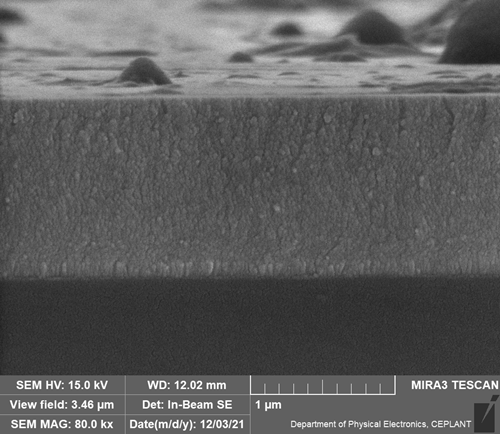Specially designed antibacterial coating under practical testing
Bacteria, be aware! Researchers developed a protective coating resistant to wear that inhibits the multiplication of microorganisms on exposed surfaces. Practical testing will reveal levels of coating's degradation in time and by use. This research is a joint effort of the Deposition of Thin Films and Nanostructures Research Group at the Department of Physical Electronics MU, the Czech Collection of Microorganisms at the Department of Experimental Biology MU, and the company SHM Šumperk.
16 Aug 2022
Tereza Schmidtová
Researchers from the Department of Physical Electronics developed a special antibacterial coating. In our faculty, these coatings are undergoing the first practical trial in their intended environment. The results of these tests will be available in a few months. The specific future application will be selected through the true potential of these coatings.
This research is a joint effort between the Deposition of Thin Films and Nanostructures Research Group at the Department of Physical Electronics MU Faculty of Science and the Czech Collection of Microorganisms at the Department of Experimental Biology at MUNI Faculty of Science, and private company SHM in Šumperk.
The developed coating is currently put through long-term testing of degradation in time and by use. Researchers mounted these protective coatings on door handles in selected areas of campuses in Bohunice and Kotlářská, Faculty of Science. Coatings on door handles are periodically tested on the levels of reduction of their antimicrobial properties in time and by wear by mechanical use, degradation by disinfectants, sweat, hand cremes, or other factors.
As Covid-19 struck the world, protection from viruses and bacteria became the focus topic. Researchers from the Deposition of Thin Films and Nanostructures Research Group were approached by their long-term partner company SHM Šumperk. Together, they designed and prepared a coating with antibacterial properties.
The goal was to create a thin, protective, antiviral, and antibacterial coating that would also be resistant to abrasion and directly inhibit the multiplication of microorganisms on its surface. This material would have to have lasting effects and prevent recontamination on its surface. Unlike classical disinfectants, it would not cause any allergic skin reactions.
Researchers from the Deposition of Thin Films and Nanostructures Research Group at DPE applied for TRIO project from MIT programs: https://starfos.tacr.cz/en/project/FV30262. The project successfully ended in 2021. "We have managed to design and develop a coating with a nanostructure that is wear-resistant and two times harder than steel! For example, you would not scratch it with a ring. Alas, this coating does not have any significant antiviral properties. However, it works well on bacteria. We chose to pursue further long-term antimicrobial testing to specify future applications," says the head of Researchers at the Deposition of Thin Films and Nanostructures Research Group and the director of the Department of Physical Electronics prof. Mgr. Petr Vašina, Ph.D.
The team working on the TRIO project developed a new physical method of preparation of such coatings. Researchers deposited these coatings in the industrial conditions of SHM Šumperk Company. These coatings are based on copper-doped nitrides of transition metals.
Dr. Vjačeslav Sochora, the leader of the development team of SHM company, hopes that this proven technological method of preparation of these antibacterial thin films in industrial conditions will widen SHM Company's portfolio of coatings for those suitable for application in health care, education, or food processing industry.
Deposited Cu-dopped ZrN films are hard, wear-resistant, and inhibit the growth and multiplication of microorganisms. Ph.D. student Sahand Behrangi, M.Sc., focuses on this research as a part of his Ph.D. studies. He says:" If the protective layer worked on tested door handles, it would work in practical applications. Another good aspect of this protective layer is its decorative property. It appears to be gold in color, which makes it attractive-looking."

Petri dishes used to determine the levels of multiplication of selected bacteria
Researchers specially developed these coatings to withstand extremely exposed areas such as infectious disease wards in hospitals, public spaces, schools, retirement homes, and social institutions. In these places, there is a need to eliminate the source of nosocomial infection and prevent the creation of a biofilm to eliminate the spread of infection.
Antiviral effect of protective layer was tested directly on SARS-CoV2 virus with a 3-day incubation period. The virus titration evolution in time did not show any significant antiviral effect. Researcher Sahand Behrangi, M.Sc. further comments: "The only samples with antiviral properties had high copper content or ended with a pure copper layer on the top of ZrN layer."
The head of Czech Collection of Microorganisms from the Department of Experimental Biology, prof. RNDr. Ivo Sedláček, CSc. says: "In the hospital environment, common bacteria can become conditional pathogenic organisms under specific conditions. In that case, they would not need hosts as primary pathogens. The tested coatings can prevent that and work well in highly exposed environments. "
Researchers selected the common bacteria Escherichia coli for testing after the exposure of handles. The multiplication of bacteria in Petri dishes and subsequent result analysis will give researchers the final answer if these coatings can work long-term. The experiment has been running for the third month, people are touching the installed handles, contaminating them, but the coatings still show antibacterial properties and work as expected.










